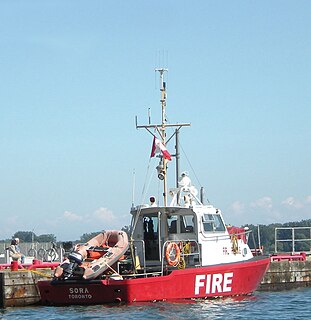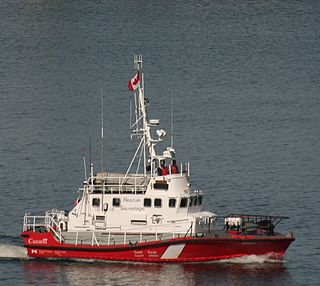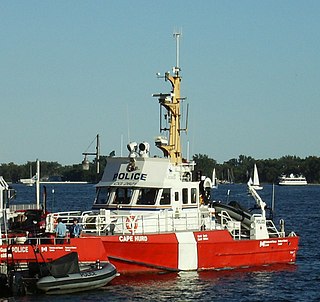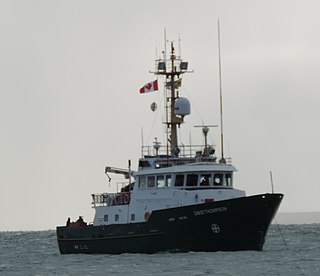Gallery
- Arun class lifeboat
- Maid of the Mist V
- CCG hovercraft Siyay
- Toronto Island car ferry
This article is being considered for deletion in accordance with Wikipedia's deletion policy. Please share your thoughts on the matter at this article's deletion discussion page. |
Hike Metal Products is a Wheatley, Ontario-based manufacturer of small to mid-sized boats used for firefighting, lifeboats, research vessels, law enforcement and other rescue and patrol operations. The company also performs ship refitting and metal fabricating.
Founded in 1958, the company's clients are in Canada and United States, with vessels used mostly in the Great Lakes. The company faced financial problems in the 1980s and restructured to meet changing business environment. [1]
Hike's facilities are located within Wheatley Harbour, consisting of a large metal-manufacturing building, outdoor building berths. [2] Assembly of vessels take place outside (vessels over 100 ft in length and inside (less than 100 ft in length). Located along Lake Erie, the business caters to regional buyers, namely Canadian and American clients along the Great Lakes.
Hike is one three surviving Canadian shipbuilders on the Great Lakes with most others disappearing after World War II:
Hike is the only Canadian shipyard on Lake Erie, but second to be located on the lake:
Other Great Lakes shipbuilders include:
(Dry Dock Engine Works and the Detroit Dry Dock Company) 1892–1929

The Canadian Coast Guard is the coast guard of Canada. Formed in 1962, the coast guard is tasked with marine search and rescue (SAR), communication, navigation, and transportation issues in Canadian waters, such as navigation aids and icebreaking, marine pollution response, and support for other Canadian government initiatives. The coast guard operates 119 vessels of varying sizes and 23 helicopters, along with a variety of smaller craft. The CCG is headquartered in Ottawa, Ontario, and is a special operating agency within Fisheries and Oceans Canada.

CCGS Alexander Henry is a former Canadian Coast Guard light icebreaker and buoy tender that served on the Great Lakes from 1959 to 1984. In 1986, the vessel was handed over to the Marine Museum of the Great Lakes in Kingston, Ontario for preservation as a museum ship. Previously, during the summer months the vessel was also operated as a bed and breakfast. In 2017, the ship was sold to the Lakehead Transportation Museum Society in Thunder Bay, Ontario and in June, was relocated to the Pool 6 site on the town's harbour front, where Alexander Henry continues as a museum ship.

USS Niagara, commonly called the US Brig Niagara or the Flagship Niagara, is a wooden-hulled snow-brig that served as the relief flagship for Oliver Hazard Perry in the Battle of Lake Erie during the War of 1812. As the ship is certified for sail training by the United States Coast Guard, she is also designated SSV Niagara. Niagara is usually docked behind the Erie Maritime Museum in downtown Erie in the U.S. state of Pennsylvania as an outdoor exhibit for the museum. She also often travels the Great Lakes during the summer, serving as an ambassador of Pennsylvania when not docked. It was listed on the National Register of Historic Places in 1973 and was designated the official state ship of Pennsylvania by the Pennsylvania General Assembly in 1988.

Amherstburg Royal Naval Dockyard was a Provincial Marine and then a Royal Navy yard from 1796 to 1813 in Amherstburg, Ontario, situated on the Detroit River. The yard comprised blockhouses, storehouses, magazine, wood yard and wharf. The yard was established in 1796 to support the Upper Canada Provincial Marine after Great Britain ceded a pre-existing shipyard on the Detroit River to the United States. Amherstburg Royal Naval Dockyard constructed four warships for the Lake Erie detachment of the Provincial Marine before and during the War of 1812. In 1813 the dockyard was abandoned and destroyed when the British retreated and never reopened. In 1928, the site was designated a National Historic Site of Canada.

CCGS Sora was a 12.5m Small Multi Task Utility Craft that has seen service with the Canadian Coast Guard and Toronto Fire Services. It was deployed for medium range task and perform under moderate to high speed in moderate weather conditions and in sheltered waters in station mode. In 2005, it was transferred to Toronto and used as part of the Fire Services fleet. It was finally retired in 2015.

Burrard Dry Dock Ltd. was a Canadian shipbuilding company headquartered in North Vancouver, British Columbia. Together with the neighbouring North Van Ship Repair yard and the Yarrows Ltd. yard in Esquimalt, which were eventually absorbed, Burrard built over 450 ships, including many warships built and refitted for the Royal Navy and Royal Canadian Navy in the First and Second World Wars.

Provincial Marine was a coastal protection service in charge of the waters in the Great Lakes, the St. Lawrence River and parts of Lake Champlain under British control. While ships of the Provincial Marine were designated HMS, they were operated in more of a coast guard manner than as a full-fledged navy. Operations were maintained and staffed by the Royal Navy. Most ships of the Provincial Marine were built on the Great Lakes.
Port Weller Dry Docks was a shipbuilder located on the Welland Canal at the Lake Ontario entrance. The shipbuilder was founded in 1946 and the site was initially owned by the Government of Canada for storage purchases. The shipyard expanded to include ship repair, and reconstruction work. In 1956, the drydock was sold to the Upper Lakes Shipping Company, which began the construction of vessels at the site. The shipyard twice went insolvent, most recently in 2015. Port Weller Dry Docks was used to build, refit and repair cargo vessels.

CCGS Sambro is a Canadian Coast Guard motor lifeboat homeported in Sambro, Nova Scotia.
HMS General Hunter was a 10-gun brig of the Upper Canada Provincial Marine then, in 1813, the Royal Navy for their squadron on Lake Erie. She was ordered and built as a schooner in 1806 to replace Hope, a Provincial Marine vessel that had run aground in 1805. General Hunter was launched in 1807, entering service that year. With the outbreak of the War of 1812, General Hunter was converted to a brig and rearmed. As part of the Lake Erie squadron, General Hunter was present at the Battle of Lake Erie where the United States Navy defeated the British and gained control of the lake. General Hunter was captured at the battle and taken into American service. With the ship's name shortened to Hunter, she was used as a transport for the rest of the war. Following the war, the ship was sold into mercantile service. In 1816, the ship ran aground in a storm on Lake Huron and wrecked. The ship's contents were salvaged, but the wreck was left to be buried under the sand. In 2004, the wreck became the site of archaeological excavations and artifacts were retrieved from the site and placed in museums.
Queen Charlotte was the ship-rigged ship-sloop constructed for the Upper Canada Provincial Marine in 1810 as part of the fleet renewal in the lead-up to the War of 1812. Ordered in 1809, the ship was designed by Master Shipwright William Bell and constructed at Amherstburg Royal Naval Dockyard in Amherstburg, Upper Canada on Lake Erie. The design was based on the Snake class and was considered an effective design. During the War of 1812, Queen Charlotte was part of the Lake Erie squadron. After the Royal Navy took over command of the Great Lakes, Queen Charlotte was commissioned in 1813. On 10 September 1813, Queen Charlotte and the rest of the Lake Erie squadron were captured at the Battle of Lake Erie. The ship entered service with the United States Navy, though after the defeat of the British squadron, saw no further action during the war. Following the war, the ship was intentionally sunk at Put-in-Bay near Erie, Pennsylvania for preservation. Raised and sold into commercial service in 1825, the vessel continued in service until 1844, when the ship was no longer considered serviceable and left to rot as a dismasted hulk.

CCGS Siyay is a Canadian Coast Guard Type 400 BHC AP1-88/400 hovercraft based in Richmond, British Columbia. The vessel was ordered in 1996 and launched and entered service in 1998. The hovercraft is predominantly used for servicing navigational aids and search and rescue duties.

CCGS Sipu Muin is a Canadian Coast Guard Type 400 AP1-88 air cushion vehicle (ACV) or hovercraft based at CCG Hovercraft Base Trois-Rivières in Trois-Rivières, Quebec. The vessel was launched and completed in 1998 and entered service the same year. Sipu Main is predominantly used for icrebreaking, search and rescue, and for servicing navigational aids in the Lower Saint Lawrence River and St. Lawrence Seaway.
CCGS Waban-Aki was a Canadian Coast Guard hovercraft based at CCG Hovercraft Base Trois-Rivières in Trois-Rivières, Quebec. It was a Type 200 AP1-88 air-cushioned vehicle (ACV) and sister ship to CCGS Sipu Muin. Its name is derived from the First Nations term Wabanaki meaning "people of the dawn". The hovercraft decommissioned in 2010 and was replaced by CCGS Mamilossa. The primary missions of Waban-Aki were icebreaking and performing search and rescue missions in the Saint Lawrence River and its navigable tributaries. Occasionally Waban-Aki performed navigation aid maintenance.

The Canadian Coast Guard (CCG) maintains a fleet of 14.6 m Cape-class motor lifeboats based on a motor lifeboat design used by the United States Coast Guard. In September 2009 the CCG announced plans to add five new lifeboats, bringing the total number of Cape-class lifeboats to 36.
CCGS Mamilossa is a Canadian Coast Guard Hoverwork AP1-88/400 Air Cushioned Vehicle or hovercraft based at CCG Hovercraft Base Trois-Rivières, QC. The hovercraft was their first built in the UK, the CCGS Sipu Muin and CCGS Siyay were built under license by Hike Metal Products of Wheatley, Ontario, Canada. She is the largest hovercraft exported by British shipbuilders.
Collingwood Shipbuilding was a major Canadian shipbuilder of the late 19th and 20th centuries. The facility was located in the Great Lakes and saw its business peak during the Second World War. The shipyard primarily constructed lake freighters for service on the Great Lakes but also constructed warships during the Second World War and government ships postwar. The shipyard was closed permanently in 1986 and the land was redeveloped into a new housing community.

CCGS Cape Hurd is a 21.4-metre (70 ft) mid-shore patrol vessel formerly serving with the Canadian Coast Guard and last stationed in Sarnia, Ontario. The vessel is classed for inland waters with no ice-class. It now serves as a fireboat in Toronto.

RV David Thompson is a Parks Canada mid-shore scientific research and survey vessel, that entered service in 2016. David Thompson has been used to carry out underwater archaeology work with Parks Canada during the survey of HMS Erebus and HMS Terror, the two Franklin Expedition ships lost in Northern Canadian waters. The vessel was formerly a fisheries patrol vessel of the Canadian Coast Guard named CCGS Arrow Post.
{{cite web}}: CS1 maint: archived copy as title (link)